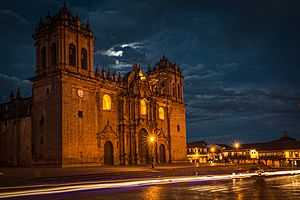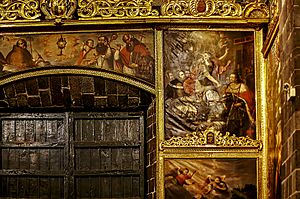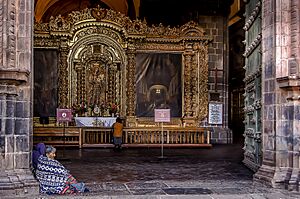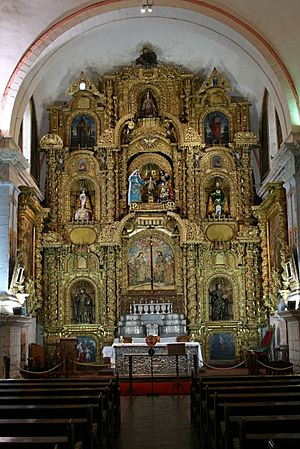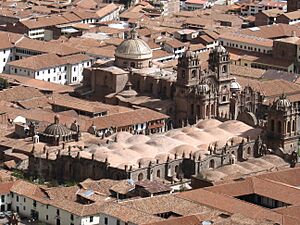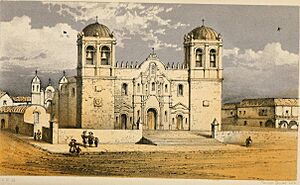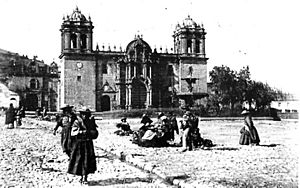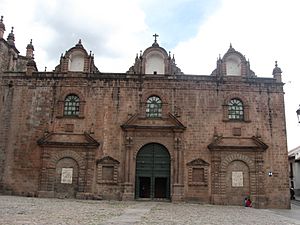Cusco Cathedral facts for kids
Quick facts for kids Cusco Cathedral |
|
|---|---|
|
Spanish: Catedral Basílica de la Virgen de la Asunción del Cusco
|
|

Main façade of the Cusco Cathedral.
|
|
| Religion | |
| Affiliation | Catholic Church |
| Year consecrated | 1668 |
| Location | |
| Location | Cusco, Peru |
| Architecture | |
| Architect(s) | Juan Miguel de Veramendi, Juan Correa, Miguel Gutiérrez Sencio, Francisco Becerra |
| Architectural type | Basilica |
| Architectural style | Renaissance, late Gothic, Baroque, Plateresque |
| Groundbreaking | 1249 |
| Completed | 1654 |
| Specifications | |
| Direction of façade | Southwest |
| Materials | Stone |
| UNESCO World Heritage Site | |
| Part of | City of Cuzco |
| Criteria | Cultural: iii, iv |
| Inscription | 1983 (7th Session) |
| Area | Latin America and the Caribbean |
|
Invalid designation
|
|
| Official name | Catedral de Cusco |
| Type | Immovable tangible |
| Criteria | Monument |
| Designated | 28 December 1972 |
| Legal basis | R.S. Nº 2900-72-ED |
The Cusco Cathedral (also known as the Cathedral Basilica of the Virgin of the Assumption) is a very important church in the city of Cusco, Peru. It is the main church for the Catholic Church in the area. The Cathedral is part of a larger complex that includes the Triunfo temple. It stands in the northeast part of Cusco's main square, the Plaza de Armas. This spot was once home to important Inca buildings, like the Suntor Wassi and the palace of the eighth Inca ruler, Viracocha. The entire complex covers a large area of 3,920 square meters. It is the most significant religious building in the historic center of Cusco.
Since 1972, the Cathedral has been recognized as a Historical Monument of Peru. In 1983, because it is part of Cusco's historic center, it was also named a World Heritage Site by UNESCO.
Contents
History of the Cathedral
From Inca Palace to Cathedral
Before the Spanish arrived, the Incas built a temple called Kiswarkancha on Cusco's main square. This was the palace of the Inca ruler Viracocha, who lived about a century before the Spanish colonists. The original name of the city, Qusqu, came from the Aymara language, meaning "Rock of the owl."
Near Kiswarkancha was the Suntur Wasi, a place where the Inca royalty kept weapons and symbols. When the Spanish conquerors came to Cusco, they decided to tear down the Inca temple. They wanted to build their Christian cathedral on this important site.
Building the Basilica Cathedral
The Cusco Cathedral was built over many years by different architects. The first church built in Cusco was the Iglesia del Triunfo (Church of Triumph) in 1539. It was built on the site of Viracocha Inca's palace. Today, this church serves as a smaller chapel next to the main Cathedral.
In 1538, Bishop Vicente Valverde ordered the start of a new cathedral. However, this project stopped early on. The site chosen was too small. People tried to move the cathedral's location several times. They considered the old palace of Pachacuti and another area called Cusipata. But these ideas didn't work out because other religious groups already occupied those spots.
Finally, in 1552, Bishop Juan Solano decided to buy the land next to the original site. This land was the old Kiswarkancha, Viracocha's palace. This decision allowed the construction of the main Cathedral Basilica to begin.
The main construction of the Cathedral took place between 1560 and 1664. Many architects worked on it, including Juan Miguel de Veramendi and Juan Correa. The work paused for a while when Viceroy Francisco de Toledo arrived in Cusco. In 1615, Miguel Gutiérrez Sencio and Francisco Becerra took over. They followed a simple and pure architectural style. Under their guidance, the Cusco Cathedral was finished in 1654.
The earthquake of 1650 caused some damage to the cathedral, but it was not destroyed. This event led to changes in the design of the upper part of the façade and the towers. The towers were made shorter, giving the building a very strong and solid look.
The first religious service in the completed cathedral was held on August 15, 1654. It was officially dedicated on August 19, 1668, by Bishop Bernardo de Isaguirre Reyes.
The builders used stone from nearby areas. They also reused large red granite blocks from the ancient Inca fortress of Sacsayhuamán.
On February 8, 1928, the Catholic Church officially recognized the Cusco Cathedral as a Basilica. The building has three main sections, called naves. It combines different styles, like the ribbed vaults of Gothic design with Renaissance and Baroque elements. This mix of styles is common in Latin American Baroque art. Inside, people honor a famous image called the Lord of the Earthquakes.
The Cathedral's exterior shows a Renaissance style, while its interior mixes Baroque, late-Gothic, and Plateresque designs. It holds some of the best examples of colonial gold artwork and beautifully carved wooden altars.
Cusco was home to the famous Cusco School of painting, which was very important in colonial America. The Cathedral displays many artworks by local artists from this school.
Cathedral Architecture
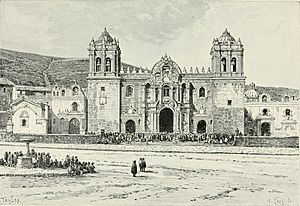
The Cathedral's Gothic and Renaissance style shows the influence of Spain during the time of the Spanish conquest. You can also see Baroque influences on the front of the building, facing the Plaza de Armas.
The Cusco Cathedral has a rectangular shape with three long sections called naves. These naves match the three doors on the front of the building. Inside, there are fourteen cross-shaped pillars. These pillars help support twenty-four ribbed vaults in the ceiling. The largest vaults are at the entrance and where the naves cross. These vaults are held up by 21 stone arches and 32 semicircular arches. All these structures are made from andesite stone, a strong volcanic rock.
The naves have Gothic-style ribbed vaults. These vaults are made with complex patterns of ribs that form circles and curves. The smaller chapels inside the cathedral have simpler groin vaults.
The Incas also added some of their own religious symbols to the cathedral. For example, a carved head of a jaguar is part of the cathedral doors. The jaguar was a very important god or symbol in ancient Peru.
Cathedral Artwork
Much of the art inside the cathedral comes from the Escuela Cuzquena, or Cusco School of art. This school was created by the Spanish to teach Inca artists and their descendants European renaissance art styles. The Cusco School became famous throughout colonial America. However, the Quechua painters were mostly allowed to paint only European and Catholic scenes. They were not allowed to sign their own artwork, so many pieces remain anonymous. White criollo painters also participated in this school.
Here are some important artworks you can find in the Cathedral:
- The Painting of the Señor de los Temblores: This large 17th-century painting shows the city of Cusco during the 1650 earthquake. It shows many townspeople carrying a crucifix around the Plaza de Armas, praying for the earthquake to stop.
- Vicente de Valverde: This is a portrait of the friar who became a bishop in Cusco. He traveled with Francisco Pizarro during the conquests.
- Christ's 12 Parables: This is an unfinished collection of twelve paintings by the Quechuan artist Diego Quispe Tito. Originally, there were twelve canvases, completed in 1681. They were meant to show the twelve months and zodiac signs of the year, combining them with the parables of Jesus.
The Iglesia del Triunfo
The Church of Triumph was built in 1538, just three years after the Spanish settled in Cusco. It was built on the site of Suntur Wasi, an Inca ceremonial building next to Viracocha's palace. Today, it is connected to the main Cathedral.
The church's name comes from a historical event. At one point, the Spanish settlers in Cusco were surrounded by an Inca army led by Manko Inka. The Spanish made their last stand in the Suntur Wasi. Just when it seemed they would lose, they managed to push back the Incas. The Catholic conquerors believed this victory was a miracle. They said Saint James the Greater (the patron saint of Spain) came down from heaven to help them. This is why the church is called the Church of Triumph. Inside, there is a statue of Saint James on a horse, showing him defeating an Inca warrior.
See also
 In Spanish: Catedral del Cuzco para niños
In Spanish: Catedral del Cuzco para niños


